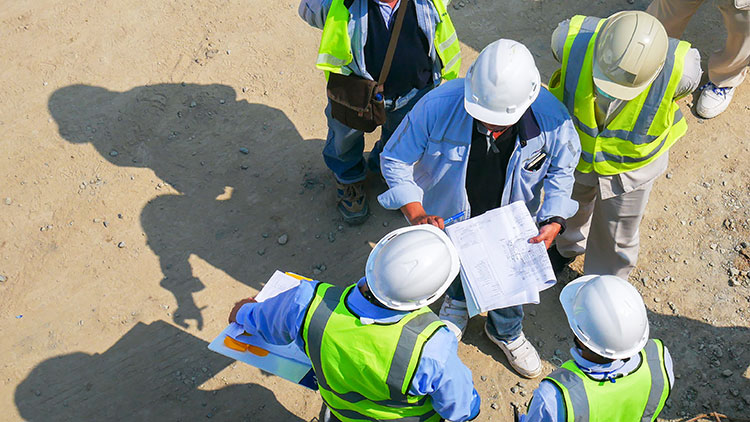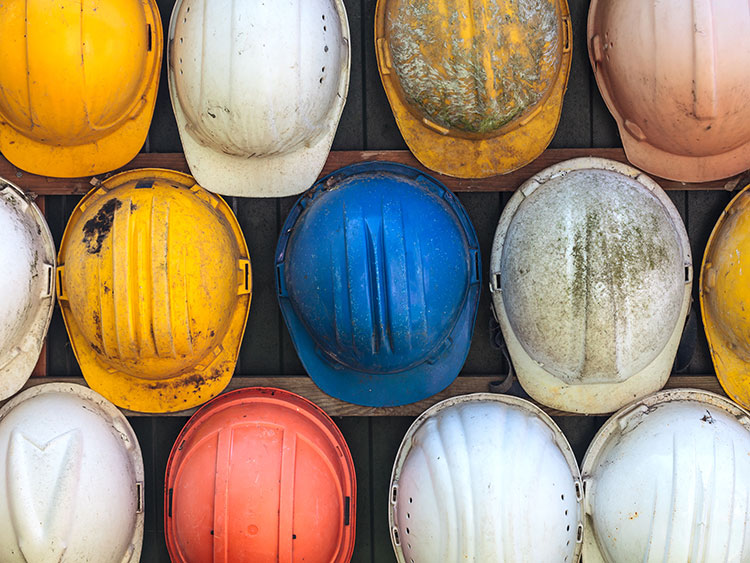Guide: Everything You Need to Know About Hard Hats
All workplaces are required to ensure the safety of their employees from possible head and bodily injuries. When you work on an industrial or construction site, you should always protect your head with the right headgear.
Commonly known as a hard hat, this headgear is a necessity in any work environment where there is a risk of head trauma or injury to employees. For instance, on construction sites, falling objects are a major concern. Industrial workers can bump their heads into pipes, beams, and other fixed, hard objects.
Hard hats are also useful in preventing electrical hazards and protecting employees against rain, heat, UV light, water, and chemical splashes.
A Bit of Background on Hard Hats
Did you know that shipbuilders were the first people who wore hard hats? These workers covered their heads with the earliest version of the hat. These helmets were coated with tar and placed in the sun for curing. Then, the shipbuilders would wear these hard hats to protect them from objects that could drop from ship decks.
The first hard hat is documented to have been created in 1912 for the Kingdom of Bohemia. However, there is not enough evidence to prove that this was the true origin of the hard hat. Protective headgear was already present in the US since 1898, or possibly even earlier. A company in California owned by Edward Dickinson sold leather hats to protect the workers’ heads.
Later on, his son came home with a steel helmet from the First World War. Edward further improved the helmet and later patented a hard hat in 1919. This hat was made with steamed canvas and covered with black paint. It was then the US Navy appointed Edward’s company to develop a protective cap for the workers.
Hard Hats Today
Hard hats have improved significantly thanks to the transition from metal and fibreglass materials to rigid plastic construction. Although the durability of metal and other materials was unquestionable, they were uncomfortable and heavy. Rigid plastic helped make the hats lighter and more comfortable to wear.
Some newer cap-style hats have rolled edges, which allow them to drain rainwater off the bill of the hat instead of dripping down the wearer’s neck.
Another type of hard hat is known as the cowboy hard hat (yes, it looks just like the name implies). In Australia, many organisations do not allow workers to use cowboy hard hats.
Companies often include their names or logos (sometimes both), along with other messages on the front of the hat.
Hard hats today have become quite versatile, allowing users to fit them with accessories such as:
- Visors
- Earmuffs
- Chinstraps
- Headlamps
- Face shields
- Cooling towels
- Liners
- Sweat protection
- Neck shades
Hard Hats in Australia
Just like in other countries, hard hats or helmets are a requirement in Australia, particularly in the construction industry. It is the responsibility of the employer to make sure that workers wear proper helmets in the workplace.
If you are self-employed, the same rules apply. Meanwhile, the employee is also required to wear the hard hat properly.
Regulation 3.36 states that safety helmets should be worn at the construction site. It is a necessity whenever the worker is performing contractor duties, as well as during times when there is a risk of any object hitting the head of the worker.
Under the Occupational Safety and Health Regulations 1996, employers must ensure a safe working environment. Risks in the workplace should be identified first. Certain workplaces are considered high-risk, especially construction sites. They typically involve a risk of the worker falling more than two metres, while others work near pressurised piping, chemicals, fuel, and electrical components.
If the employer finds there is a risk of any head trauma or injury, it is essential to provide a hard hat or helmet that complies with the Australian Standard AS/NZS 1801.
How Hard Hats Work
When you wear a hard hat that meets the standard mentioned above, it can help you stay protected against head injuries. The hat has a hard outer shell that can soften impacts and protect the skull against trauma. Inside, it comes with a shock-absorbing material that spreads the impact to greatly minimise any force felt and protect the brain.
According to the Construction Industry Profile statistics, 13,401 workers lost their lives in 2013 while at the construction site. Out of these fatalities, 15% the deaths were due to electrocution, 12% of the workers got hit by a moving object, and 11% died because of a falling object that hit their heads.
The Australian Work Health and Safety Strategy 2012-2022 has made it a priority to address these issues. The right personal protective equipment (PPE), including hard hats, plays a significant role in preventing death and injury in the workplace.
In Australia and New Zealand, the standard AS/NZS 1801:1998 specifies all the requirements when it comes to protective helmets in the workplace.
According to the standard, there are three different types of protective helmets. They are categorised based on their materials, construction, shell, and hardness.
Some workplaces need a heavier-duty hard hat than others, which is why the type should be selected properly.
Here are the classifications:
- Type 1 hard hats are for the general industrial trade.
- Type 2 helmets are for workplaces that are exposed to constant high heat.
- Type 3 helmets are for workers who are involved in bushfire fighting.
How to Choose the Right Hard Hat
Before buying a helmet, it is important to know a few key things. For instance, colour is an essential part of your decision.
In many organisations, you cannot just use any colour of hard hat because they have meanings:
- White Hard Hat – This hard hat is intended for foremen, supervisors, and engineers.
- Brown Hard Hat – If a hard hat is brown, it is typically designed for welders or workers who operate in high-heat environments.
- Green Hard Hat – Occasionally, green hard hats signify that the worker is new on the construction site. However, it is mostly worn by safety inspectors.
- Yellow Hard Hat – Most operators and general labourers wear a yellow hard hat.
- Blue Hard Hat – The blue-coloured hat is for carpenters and technical advisers. Temporary workers can also be seen wearing them in some firms.
- Orange Hard Hat – Visitors and new employees usually wear an orange hard hat. In some cases, road workers wear them as well.
It should be noted though that there is no official standard for these coloured hard hats. Some organisations choose to use just one colour, while others have specific meanings as well. All employers should provide this information to the employees, especially if there is a colour code to follow.
When you are ready to buy a hard hat, here are some tips that will help you choose the right one:
1.Pick A Comfortable Hard Hat – Today’s innovations have made headgear more comfortable due to the use of composite materials. They are also designed to be lightweight yet sturdy, so they do not get in the way as you work.
A hard hat should stay on your head securely and comfortably, without needing to be adjusted every few minutes. For instance, this MSA V-Gard Brim Hard Hat comes with self-adjusting straps, allowing you to achieve a superior fit.
2. Choose a Hard Hat Made From New Materials – Composite materials, along with ABS plastics, can withstand impacts while staying lightweight on top of your head. These hats are designed to be hard and sturdy, but they should not be heavy. Take a look at this hard hat from Pro-Choice that uses ABS plastic and HDPE/polyester for the harness.
3. Consider the Number of Suspensions – The suspension of the hard hat refers to the internal framework of the headgear that absorbs and spreads shock upon impact.
Hard hats often have four, six, or eight suspensions. These numbers show how many connections there are between the hat and the suspension. This hat comes with six-point suspensions, meaning it can spread weight and shock to a wider area. Furthermore, it maximises comfort and stability while wearing the hat.
4. Select the Right Type of Hard Hat – Knowing the type of hard hat you need for your occupation will help you narrow down your choices. Based on your trade, you will choose a Type 1, Type 2, or Type 3 helmet.
5. Consider Other Factors – There are plenty of hard hat designs, including a peakless hard hat. You should choose this hard hat if you often look up and want an unobstructed view.
A peaked hard hat is usually for those who require protection for their eyes. Peaked hard hats are also ideal for workers who often work in sunny conditions and need shade for their eyes.
Meanwhile, a full brim hat offers complete protection. It is considered the best choice for those who need to keep away from the dangers of falling objects hitting their heads. These hats are also useful against UV exposure and water-shedding.
How To Care For A Hard Hat
It is important to care for your hard hat properly to ensure it maintains its effectiveness.
Here are tips for caring for a hard hat:
- Avoid dropping or throwing your hard hat
- Do not sit on your helmet or use it as support
- Only use your hard hat for work purposes, not for sports
- Clean your hard hat regularly with mild soap and warm water and allow it to air dry
- Do not use harsh detergents to clean your hard hat
- Inspect your hard hat often, ensuring it does not have any punctures, dents, or damage
- Do not store personal belongings in the shell or suspension of your hard hat (earplugs, cigarettes, etc.) – these objects can decrease the function of your hard hat and transmit force to the head and neck upon impact
- Do not use solvents, hydrocarbon-type cleaners (kerosene, gasoline, thinner), or paints on your hard hat as these can cause subtle yet irreparable damage
- When not in use, store your helmet in a clean, dry area that is not exposed to excessive heat or direct sunlight
How Often Should A Hard Hat Be Replaced?
It is important to replace your hard hat regularly. Keep a record of when you purchased your hard hat and any damage it receives.
In general, it is recommended to replace a hard hat at least every five years, regardless of its condition.
For workplaces that see excessive sunlight, chemical exposure, or temperature extremes, hard hats should be replaced every two years, or sooner if needed. Hard hats should also be replaced if they have visible dents or cracks.
Do You Have More Questions on Hard Hats?
Everyone from builders to construction workers to shipbuilders, and many other employees, should wear a properly fitting hard hat.
At The Workers Shop, we carry a wide range of Hard Hats to suit your preferences and needs. If you need help selecting the right hard hat for your job, please feel free to reach out to our team. We’d be happy to answer any of your questions and help you find the best hard hat for your workplace.



